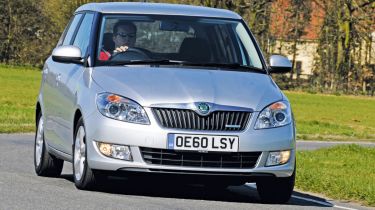Skoda Fabia Greenline II
A tiny three-cylinder engine, stop-start technology and eco optimised aerodynamics make this the greenest Skoda yet.
It achieved record sales in the UK last year, but Skoda isn’t resting on its laurels. To tap into buyers’ demand for frugal cars, it has been rolling out its second-generation GreenLine technology across the range.
The latest model to get the eco treatment is the Fabia, and it has the added kudos of being the most environmentally friendly car the firm has ever produced. It’s powered by the same three-
cylinder diesel as in the VW Polo BlueMotion, emits only 89g/km of CO2 and claims an amazing 83.1mpg combined economy.
While the longer estate is the Fabia that arguably has the practicality to rival the Jazz, it’s the bigger-selling hatch that we test here. As with the Honda, the Skoda has an upright stance on the road, but the looks are more conventional. For some people, that won’t be a good thing, and we think the Fabia is starting to appear a little dated. On top of that, the GreenLine II’s bluff rear spoiler, which cuts drag, adds little to the styling and looks like an aftermarket touch.
From the driver’s seat, the car also feels disappointingly basic. The four-spoke plastic steering wheel rim, abundance of dark trim and flimsy air-con switches leave you with the sense that you’re driving a budget car. There’s no faulting the build quality, though, and in contrast with the rest of the car, the smart £525 touchscreen sat-nav and audio system is bang up to date.
Used - available now

2023 Ford
Kuga
47,524 milesAutomaticPetrol2.5L
Cash £19,300
2020 Land Rover
Range Rover Velar
63,000 milesAutomaticDiesel3.0L
Cash £25,995
2020 BMW
X3
48,000 milesAutomaticDiesel2.0L
Cash £23,995
2020 BMW
X3
40,700 milesAutomaticDiesel3.0L
Cash £33,995The driving position isn’t bad, offering adjustment for rake and reach, and there’s lots of stowage, including a double glovebox and large door pockets. Plus, despite having a shorter wheelbase than the SEAT, the Skoda provides superior rear legroom.
The deep 315-litre boot is the biggest here, too, but you have to do without a spare wheel (as in the Jazz), while the conventional 60/40 split folding rear seats can’t match the Honda layout for flexibility.
Under the bonnet, the three-cylinder diesel delivers modest 74bhp power and 180Nm torque outputs. Add tall gearing, and performance is sluggish, with the benchmark sprint from 0-60mph taking 15.2 seconds.
On the open road, the engine needs lots of encouragement to keep up with other traffic, and overtaking requires forward planning and plenty of empty tarmac. The oil-burner also becomes intrusively noisy at high revs, while it’s gruff and lethargic at low speeds.
Around town, the stop-start system works smoothly, but the unrefined nature of the little TDI engine constantly reminds you of the sacrifice you’re making for its low emissions and consumption. The driving experience doesn’t lift the mood, either, because the suspension – lowered to optimise aerodynamics – delivers a rigid ride without providing much in the way of cornering fun.
There’s plenty of roll in bends, while the notchy mechanical action of the five-speed manual box completes a disappointing dynamic package. Some buyers will forgive this when they tot up their fuel bill. The Skoda achieved 53.7mpg during our test. But you pay a high price for this efficiency.
Details
Chart position: 2
WHY: Diesel promises amazing fuel efficiency







